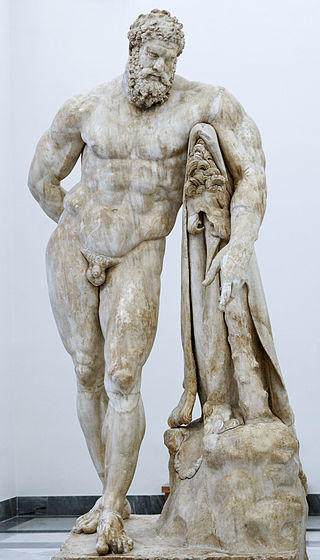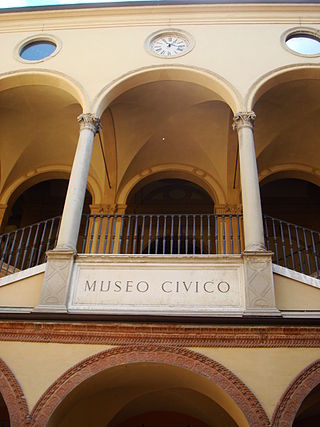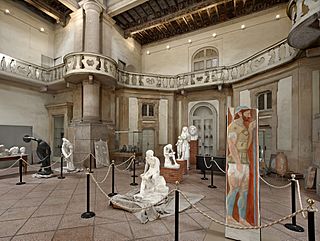
Ostia Antica was an ancient Roman city and the port of Rome located at the mouth of the Tiber. It is near modern Ostia, 25 kilometres southwest of Rome. Due to silting and the invasion of sand, the site now lies 3 km (2 mi) from the sea. The name Ostia derives from Latin os 'mouth'.

The Vatican Museums are the public museums of Vatican City, enclave of Rome. They display works from the immense collection amassed by the Catholic Church and the papacy throughout the centuries, including several of the most well-known Roman sculptures and most important masterpieces of Renaissance art in the world. The museums contain roughly 70,000 works, of which 20,000 are on display, and currently employ 640 people who work in 40 different administrative, scholarly, and restoration departments.

The Farnese Bull, formerly in the Farnese collection in Rome, is a massive Roman elaborated copy of a Hellenistic sculpture. It is the largest single sculpture yet recovered from antiquity. Along with the rest of the Farnese antiquities, it has been since 1826 in the collection of the Museo Archeologico Nazionale Napoli in Naples, inv. no. 6002, though in recent years sometimes displayed at the Museo di Capodimonte across the city. The sculpture in Naples is much restored, and includes around the base a child, a dog, and other animals not apparently in the original composition, which is known from versions in other media.

The National Archaeological Museum of Naples is an important Italian archaeological museum, particularly for ancient Roman remains. Its collection includes works from Greek, Roman and Renaissance times, and especially Roman artifacts from the nearby Pompeii, Stabiae and Herculaneum sites. From 1816 to 1861, it was known as Real Museo Borbonico.

The Torlonia Museum was a museum in Rome, which housed the Torlonia Collection of ancient sculptures.

Portus was a large artificial harbour of Ancient Rome. Sited on the north bank of the north mouth of the Tiber, on the Tyrrhenian coast, it was established by Claudius and enlarged by Trajan to supplement the nearby port of Ostia.

The study of Roman sculpture is complicated by its relation to Greek sculpture. Many examples of even the most famous Greek sculptures, such as the Apollo Belvedere and Barberini Faun, are known only from Roman Imperial or Hellenistic "copies". At one time, this imitation was taken by art historians as indicating a narrowness of the Roman artistic imagination, but, in the late 20th century, Roman art began to be reevaluated on its own terms: some impressions of the nature of Greek sculpture may in fact be based on Roman artistry.

Ostia is a large neighbourhood in the X Municipio of the comune of Rome, Italy, near the ancient port of Rome, which is now a major archaeological site known as Ostia Antica. Ostia is also the only municipio or district of Rome on the Tyrrhenian Sea, and many Romans spend the summer holidays there.

The Antalya Museum or Antalya Archeological Museum is one of Turkey's largest museums, located in Konyaaltı, Antalya. It includes 13 exhibition halls and an open air gallery. It covers an area of 7,000 m2 (75,000 sq ft) and 5000 works of art are exhibited. In addition a further 25,000–30,000 artifacts which cannot be displayed are in storage. As a museum exhibiting examples of works, which illuminate the history of the Mediterranean and Pamphylia regions in Anatolia, Antalya Museum is one of the most important of Turkey's museums. The Museum won the "European Council Special Prize" in 1988.

The National Archaeological Museum of Florence is an archaeological museum in Florence, Italy. It is located at 1 piazza Santissima Annunziata, in the Palazzo della Crocetta.

The Museo Nazionale della Magna Grecia, Museo Archeologico Nazionale di Reggio Calabria or Palazzo Piacentini is a museum in Reggio Calabria, southern Italy, housing an archaeological collection from sites in Magna Graecia.

The classical sculptures in the Farnese Collection, one aspect of this large art collection, are one of the first collections of artistic items from Greco-Roman antiquity. It includes some of the most influential classical works, including the sculptures that were part of the Farnese Marbles, their collection of statuary, which includes world-famous works like the Farnese Hercules, Farnese Cup, Farnese Bull and the Farnese Atlas. These statues are now displayed in the Naples National Archaeological Museum in Italy with some in the British Museum in London.

The Civic Museums of Pavia are a number of museums in Pavia, Lombardy, northern Italy. They are housed in the Castello Visconteo, or Visconti Castle, built in 1360 by Galeazzo II Visconti, soon after taking the city, a free city-state until then. The credited architect is Bartolino da Novara. The castle used to be the main residence of the Visconti family, while the political capital of the state was Milan. North of the castle a wide park was enclosed, also including the Certosa of Pavia, founded 1396 according to a vow of Gian Galeazzo Visconti, meant to be a sort of private chapel of the Visconti dynasty. The Battle of Pavia (1525), climax of the Italian Wars, took place inside the castle park.

The Antonino Salinas Regional Archeological Museum is a museum in Palermo, Italy. It possesses one of the richest collections of Punic and Ancient Greek art in Italy, as well as many items related to the history of Sicily. Formerly the property of the Oratory of Saint Philip Neri, the museum is named after Antonino Salinas, a famous archaeologist and numismatist from Palermo who had served as its director from 1873 until his death in 1914, upon which he left it his major private collection. It is part of the Olivella monumental complex, which includes the Church of Sant'Ignazio all'Olivella and the adjoining Oratory.

The Archaeological Civic Museum of Bologna is located in the fifteenth-century Palazzo Galvani building at Via dell'Archiginnasio 2 postal code 40124 Bologna, once known as the Hospital of Death. Founded in September 1881 by the merging of two separate museums: the one belonging to the University of Bologna – heir of the Room of Antiquity belonging to the Academy of Sciences founded by Luigi Ferdinando Marsili in (1714) – and that belonging to the City of Bologna (enriched by the antique collection of Artist Pelagio Palagi and the large amount of finds from excavations conducted in and around Bologna during these times.

The preservation and extensive excavations at Ostia Antica have brought to light 26 different bath complexes in the town. These range from large public baths, such as the Forum Baths, to smaller most likely private ones such as the small baths. It is unclear from the evidence if there was a fee charged or if they were free. Baths in Ostia would have served both a hygienic and a social function like in many other parts of the Roman world. Bath construction increased after an aqueduct was built for Ostia in the early Julio-Claudian Period. Many of the baths follow simple row arrangements, with one room following the next, due to the density of buildings in Ostia. Only a few, like the Forum Baths or the Baths of the Swimmers, had the space to include palestra. Archaeologist name the bathhouses from features preserved for example the inscription of Buticoso in building I, XIV, 8 lead to the name Bath of Buticosus or the mosaic of Neptune in building II, IV, 2 lead to the Baths of Neptune. The baths in Ostia follow the standard numbering convention by archaeologists, who divided the town into five regions, numbered I to V, and then identified the individual blocks and buildings as follows: (region) I, (block) I, (building) 1.

The Biblioteca Oliveriana is a public library located in the Palazzo Almerici on via Mazza in the town of Pesaro, region of Marche, Italy. It shares the building with the Museo Oliveriano, an archaeology museum with which it shares a common history.

The Herakleia head is the portrait of a probable Achaemenid Satrap of Asia Minor of the late 6th century, found in Heraclea, in Bithynia, modern Turkey. The head is now located in the Museum of Anatolian Civilizations in Ankara.

The Jatta National Archaeological Museum in Ruvo di Puglia, a historic and artistic city in southern Italy, is housed in rooms of Palazzo Jatta and represents the only example in Italy of a nineteenth-century private collection that has remained unaltered from its original museographic concept. The finds preserved in the museum were collected by the archaeologist Giovanni Jatta in the early nineteenth century and his collection was subsequently enriched by his nephew of the same name and was sold to the Italian state in the twentieth century.

The Museum of Archeology of the University of Pavia was established in 1819 and is, together with that of Padua, one of the oldest in Italy. The museum is located inside the ancient San Matteo hospital in Pavia.























